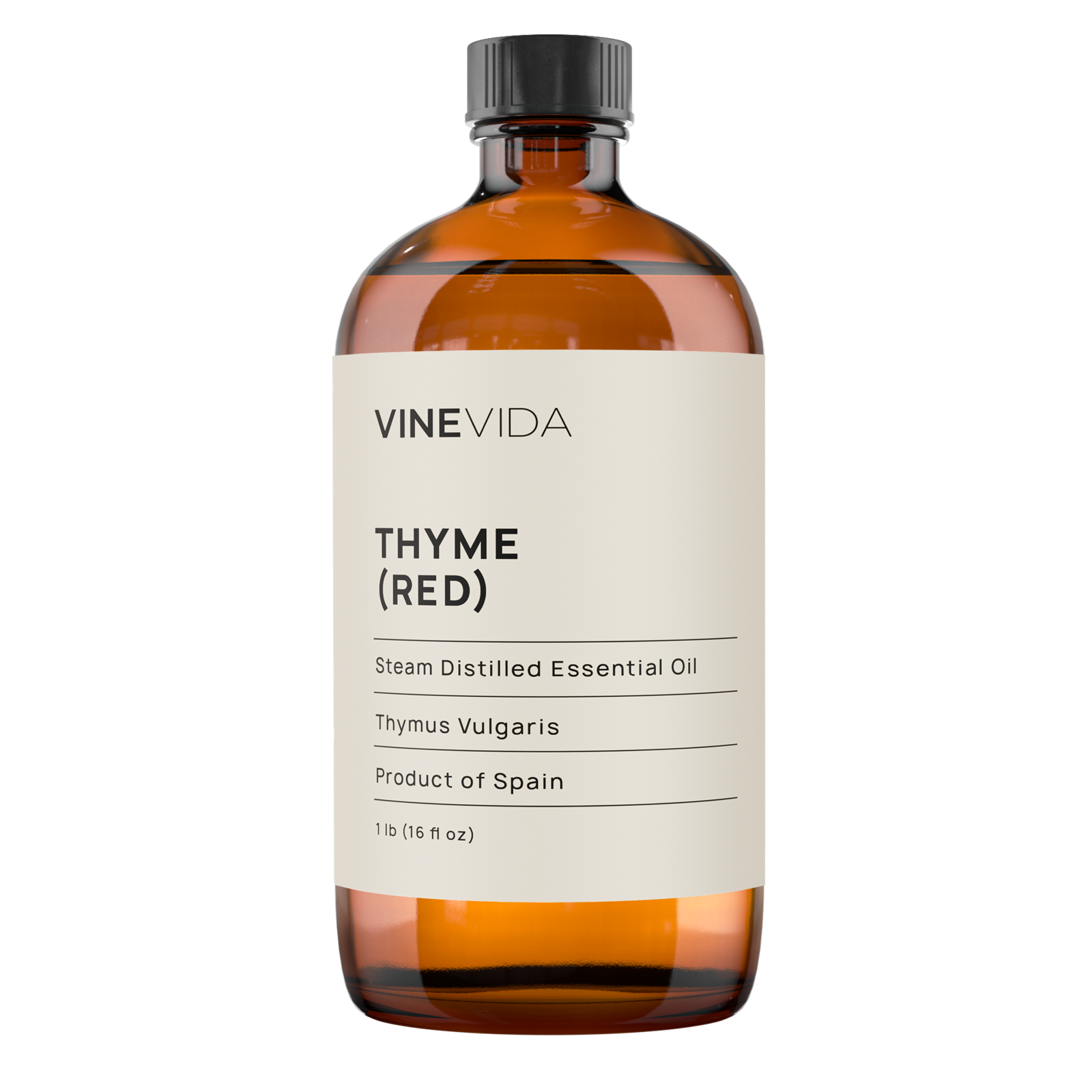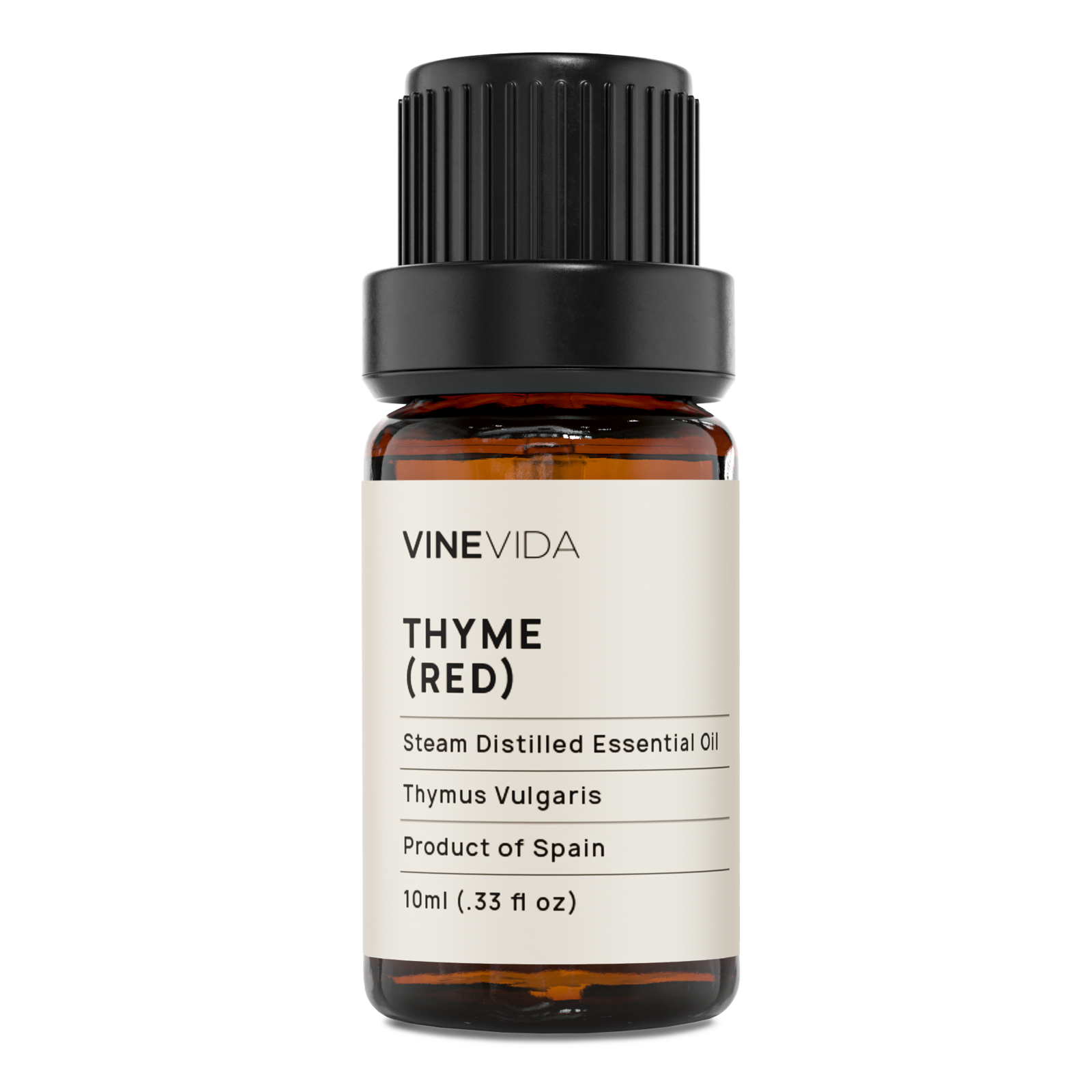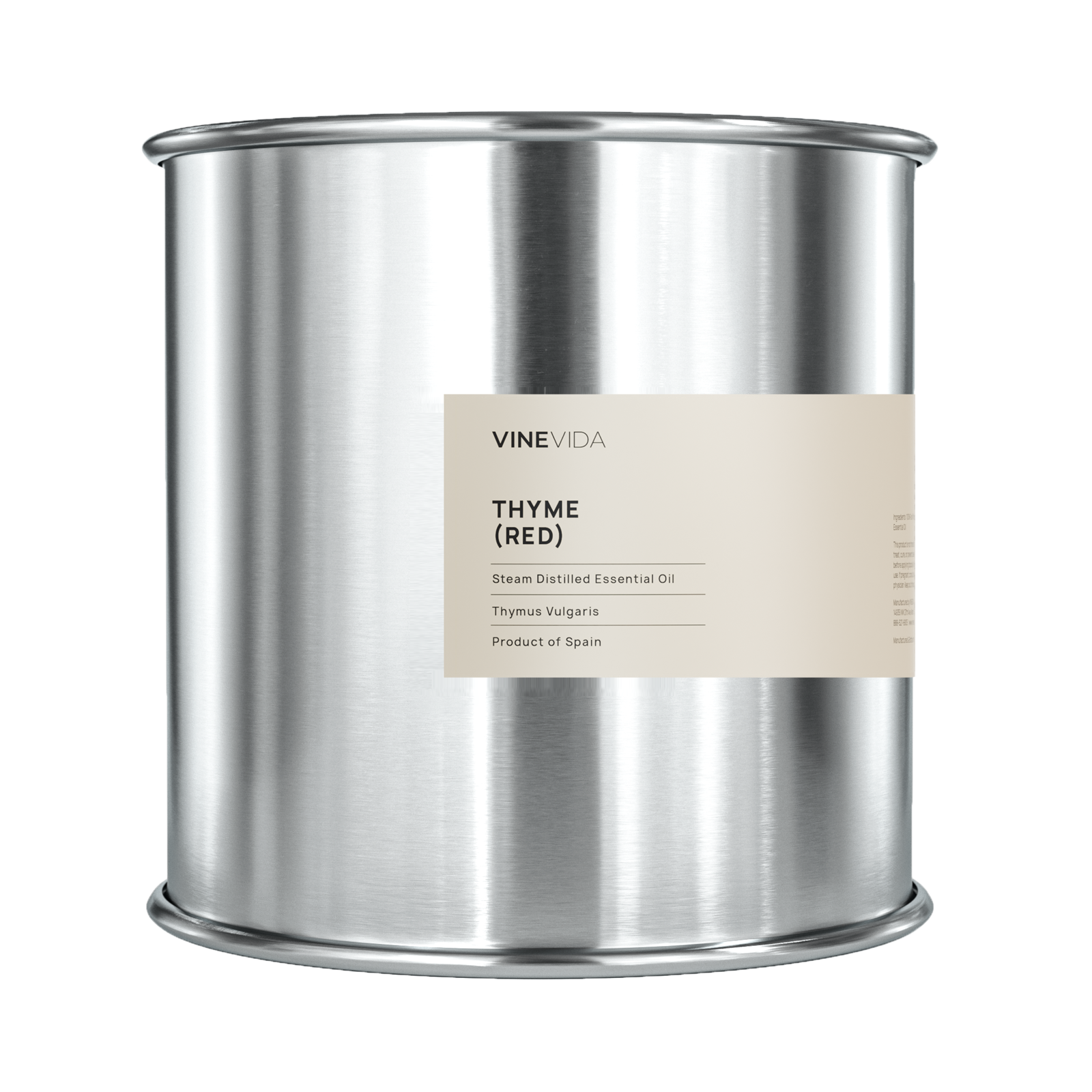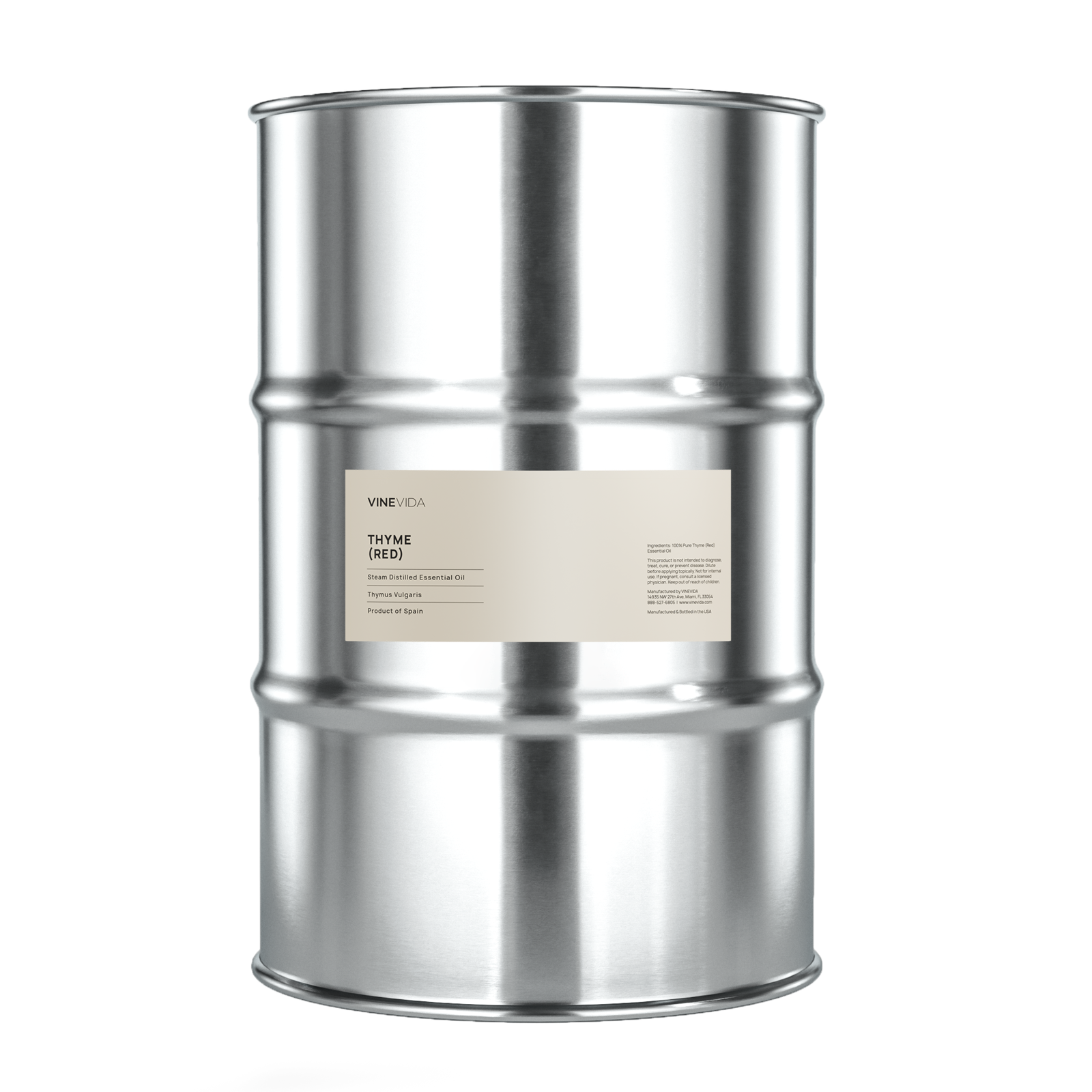Scientific Name: Thymus Vulgaris
Origin: Spain
Plant Part: Herb
Scent: Fresh, Herbaceous, and Slightly medical
Color: Pale Yellow
Consistency: Medium and Slightly Oily
Perfumery Note: Top - Middle
Initial Aroma Strength: Medium Strong
Extraction Method: Steam Distilled
Red Thyme Essential Oil: Uses, Benefits, and Blends
It’s this oil’s thyme to shine! The strong, aromatic aroma of VINEVIDA’s Red Thyme Essential Oil is indicative of the strong level of thymol it contains. Thymol is an effective antibacterial and antiseptic agent and is a common ingredient in both facial care and oral health care products. Keep reading to find out how to use Thyme Essential Oil and what other benefits it has to offer!
Red Thyme—or Thymus Vulgaris—is an evergreen species belonging to the mint family. It is native to Southern Europe, primarily to the Mediterranean regions, and is most famous for its use as a herb. You can use Thyme Fresh or dry and will find it in the aromatic herbal blend Herbes De Provence.
Thyme Essential Oil Benefits: Component Breakdown
- Thymol: Thymol is a monoterpenoid phenol and is what provides the oil with the strong, aromatic aroma we think of as Thyme. Thymol is considered to be antibacterial, antifungal, and antiseptic. Research also indicates it to be an effective antioxidant, anti-inflammatory, and, potentially, anti-cancer agent. It's the main component that contributes the most to Thyme Essential Oil benefits.
- p-Cymene: p-Cymene is natural to plants, and is classified as an aromatic monoterpene. Its aroma is both sweet and mild and it appears colorless.
- Carvacrol: Similar to thymol, carvacrol is also classified as a phenolic monoterpenoid. It is a natural component of both Oregano and Thyme Essential Oils, among others. Multiple studies indicate that carvacrol contains antimicrobial, antioxidant, and antitumor properties. However, minimal research on humans means more study is necessary.
- Gamma-Terpinene: Gamma-terpinene is a monoterpene that plays a role as both an antioxidant and a plant metabolite.
- B-Caryophyllene: A terpene with a spicy, aromatic aroma, caryophyllene is also a nonpsychoactive cannabinoid. It has antioxidant properties, and preliminary research indicates it may be effective at lowering stress and anxiety levels. hence, the Thyme Essential Oil benefits around the psychological area could be acquired with the help of this chemical component.
- Linalool: Linalool is another terpene but with a floral and fragrant aroma. It is a very popular additive and is in many products such as detergents, soaps, and cleansers. It is also a natural insecticide, and as such is listed on the US EPA website.
- a-Pinene: a-Pinene is an alkene, naturally occurring in many plants. It is thought to be effective in aiding memory retention, as well as working as an anti-inflammatory.
- a-Terpinene: Alpha, beta, and gamma monoterpenes are all common to plants. a-Terpinene is a plant metabolite, with a citrus-like aroma.
Thyme Essential Oil Uses: For Wholesale Purposes
Facial Care
When someone talks about Thyme Essential Oil uses, facial care comes first to the scene. While most people are familiar with acne, many don’t realize it’s actually an inflammatory skin condition. Furthermore, it also happens to be the most common skin affliction in the USA. Over 50 million Americans suffer from acne each year, with statistics showing that over 85% of people will experience acne at least once in their lifetime.
Research looking at the effects of Oregano and Thyme Oil shows promising results in terms of fighting acne. Common Thyme Essential Oil uses include its addition to face care products such as cleansers, toners, and moisturizers.
Oral Health Care
One of the major ingredients in Thyme Oil is thymol. The antiseptic properties of thymol led to its addition in certain popular mouthwashes, such as Listerine. Recently, more and more products are beginning to turn towards natural ingredients, such as essential oils, to stay in line with market trends.
* Please note that essential oils are not meant to be ingested, and you should only use products (such as Listerine) as directed. Continue reading for more details and precautions to take when using Thyme or other Essential Oils!
Aromatherapy
Aromatherapy—or essential oil therapy, as it’s otherwise known—can be a great way to reap the benefits of Thyme Oil.
The three main categories of Aromatherapy are massage, cosmetic, and olfactory. While massage Aromatherapy is pretty straightforward, you may be wondering what cosmetic and olfactory Aromatherapy entails.
Cosmetic Aromatherapy is the utilization of essential oils in common beauty products such as toners, moisturizers, lotions, etc. This method works great, as it combines the calming benefits of Aromatherapy with the cosmetic benefits some essential oils can provide. Additionally, it can also mean the absence of synthetic fragrances, as this is something essential oils naturally provide.
Olfactory Aromatherapy simply refers to inhalation. You can inhale the aromas of essential oils by sniffing from the bottle, using a diffuser, or even placing oils onto certain types of jewelry.
Thyme Oil is a great option for its Aromatherapy as anecdotal claims have long indicated its use in the treatment of respiratory ailments. If you are suffering from symptoms of a cold or flu, try placing a few drops of essential oil in a bowl of hot water. Use a towel to make a sort of tent over your head, then breathe in the steam. Alternatively, you can also add a few drops to a hot bath or foot bath.
Soap Making
 Soap making is another great one from the Thyme Essential Oil uses list. The main ingredient in thyme is thymol, which is a powerful antiseptic and antibacterial. If that wasn’t enough of a reason to give this oil the Thyme of the day, its warm, spicy aroma should be! To take your soap to the next level, try adding in real bits of herb for some added color, decoration, and texture.
Soap making is another great one from the Thyme Essential Oil uses list. The main ingredient in thyme is thymol, which is a powerful antiseptic and antibacterial. If that wasn’t enough of a reason to give this oil the Thyme of the day, its warm, spicy aroma should be! To take your soap to the next level, try adding in real bits of herb for some added color, decoration, and texture.
What Blends Well with Thyme Essential Oil?
To use Thyme Oil to help reduce symptoms of cold and flu, try combining it with oils such as Oregano, Eucalyptus, Tea Tree, and Cedarwood. For aromatic uses, Thyme pairs well with Lavender, Grapefruit, and Bergamot Oils.
DIY Room Spray
Thyme has antibacterial and antifungal properties, making it a great addition to natural room freshening sprays.
What you will need
- Dark, glass spray Bottle (2oz)
- 2 oz. Distilled water (or boiled tap water)
- 20 drops of Lemon Essential Oil (Citrus Limon)
- 10 drops of Red Thyme Essential Oil (Thymus Vulgaris)
- 6 drops of Eucalyptus Essential Oil (Eucalyptus Globulus)
Combine essential oils in a dark, glass bottle, then top with water. Shake to combine before use, and store in a dark, cool, place.
Precautions
As with any other essential oil, there are standard precautions to take when using Thyme Oil. Do not ingest it, and do not apply it directly to the skin without first diluting it with a Carrier Oil. Limited research has been done on the effects of using essential oils while pregnant, so it is best to avoid use. Always confer with a doctor or medical professional if you have any questions or concerns.
Flash Point
95°C
Conclusion
Thyme Oil contains a large amount of the component thymol, which is active in many biological activities. Thyme Oil is common in Aromatherapy, oral health care, and facial care products—particularly those targeting acne, such as toners. Its aromatic fragrance can offer an uplifting aroma to any room, while also working as an antibacterial and antifungal.

- Reviews
- Questions

Fast delivery. Very well packaged. Excellent quality products at unbeatable prices.
wonderful oil
I use this in my oil that I create for pain. It is a great light oil with a nice scent. I know when I purchase from this company I will be getting the top quality oil that I have received from day one

What a versatile oil!
I didn't realize the versatility of Thyme oil until I read about it here at Vinevida. My recipe for Bug repellant called for thyme oil so I purchased it for that purpose. I can see I can use it for so much more.
You may also like
Recently viewed














 Safety Data Sheet
Safety Data Sheet

















